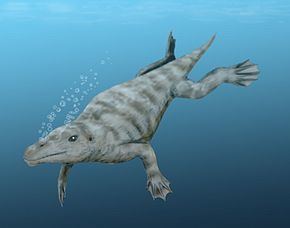Rank Family | Phylum Chordata | |
 | ||
Similar Remingtonocetidae, Basilosauridae, Pakicetidae, Archaeoceti, Protocetus | ||
The protocetids form a diverse and heterogeneous group of cetaceans known from Asia, Europe, Africa, and North America.
Contents
Description
There were many genera, and some of these are very well known (e.g., Rodhocetus). Known protocetids had large fore- and hindlimbs that could support the body on land, and it is likely that they lived amphibiously: in the sea and on land. It is unclear at present whether protocetids had flukes (the horizontal tail fin of modern cetaceans). However, what is clear is that they are adapted even further to an aquatic life-style. In Rodhocetus, for example, the sacrum – a bone that in land-mammals is a fusion of five vertebrae that connects the pelvis with the rest of the vertebral column – was divided into loose vertebrae. However, the pelvis was still connected to one of the sacral vertebrae. Furthermore, the nasal openings are now halfway up the snout; a first step towards the telescoped condition in modern whales. Their supposed amphibious nature is supported by the discovery of a pregnant Maiacetus, in which the fossilised fetus was positioned for a head-first delivery, suggesting that Maiacetus gave birth on land. The ungulate ancestry of these early whales is still underlined by characteristics like the presence of hooves at the ends of toes in Rodhocetus.
Taxonomy
The protocetid subfamilies were proposed by Gingerich et al. 2005. They placed Makaracetus in its own subfamily (Makaracetinae) based on its unique adaptations for feeding (including only two incisors in each premaxilla). They then erected two subfamilies for the rest of the protocetids based on their degree of aquatic adaptation:
Protocetinae- Protocetines are Lutetian protocetids with generalized skulls retaining three incisors in the premaxilla and three molars in the maxilla. To the extent postcrania are known, they also have a pelvis similar to those in land-living mammals, with a sacrum composed of several fused vertebrae, articulated to the ilia and innominates, and large hindlimbs used for foot-powered propulsion.
Georgiacetinae- Georgiacetines are Bartonian protocetids transitional to the basilosaurids. Their skulls and dentition is similar to those of protocetines, but their pelvis is usually reduced without substantial articulations between the sacrum and the ilia and innominates. No hindlimbs have been found, but the reduced pelvis indicates that they probably swam using their tail rather than their feet.
